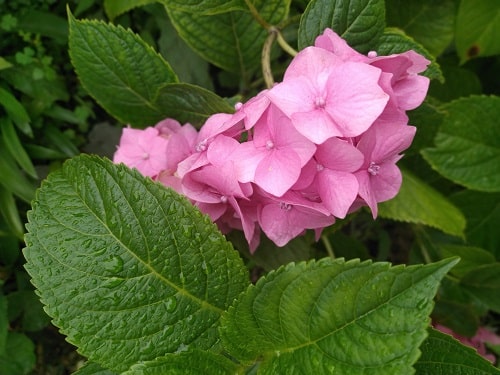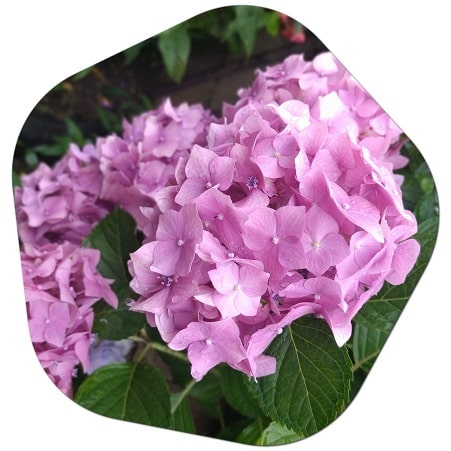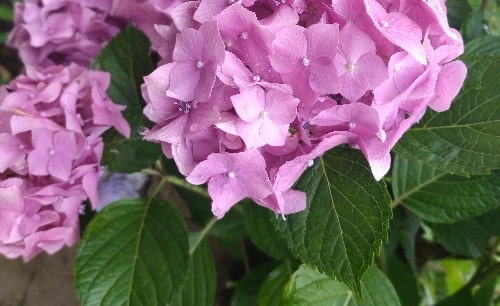There are about 80 naturally known species. They are green in summer or evergreen. Especially in tropical regions, there are also species in the form of climbing plants. However, they are usually shrub-shaped plants. Leaves are opposite, entire or segmented. The flowers are white, blue, pink, red. Hydrangeas can be grown in Canada. Hydrangeas are popular flowering shrubs that can thrive in various climate zones, including those found in Canada. However, the specific success of growing hydrangeas will depend on the region within Canada and the particular variety of hydrangea.
In general, hydrangeas prefer temperate climates with mild summers and cool winters. They can tolerate a wide range of soil conditions but prefer well-drained soil with organic matter. Hydrangeas thrive in locations with partial shade or morning sun with afternoon shade. They typically require regular watering to keep the soil consistently moist but not waterlogged.

In Canada, hydrangeas are commonly grown in regions with suitable climate conditions, such as the southern parts of British Columbia, Ontario, and Quebec. However, with proper care and consideration of local conditions, it is possible to grow hydrangeas in other parts of Canada as well. It’s recommended to choose hydrangea varieties that are known to be more cold-hardy, such as the “Annabelle” hydrangea (Hydrangea arborescens) or the “Endless Summer” series (Hydrangea macrophylla), which have been bred for their ability to withstand colder climates.
If you are interested in growing hydrangeas in Canada, it is advisable to consult with local gardening experts, nurseries, or extension services in your specific region for guidance on selecting the right hydrangea varieties and caring for them in your particular climate.
How do you winter hydrangeas in Canada?
Winterizing hydrangeas in Canada is important to protect them from the harsh conditions of cold temperatures, freezing winds, and heavy snowfall. Here are some guidelines to help you winterize your hydrangeas:
- Mulching: Apply a layer of mulch around the base of the hydrangea plant before the first frost. Use organic materials like shredded leaves, straw, or pine needles to provide insulation and protect the roots from freezing temperatures. The mulch should be around 3-4 inches deep.
- Pruning: Prune your hydrangeas after they have gone dormant in late fall or early winter. However, it’s important to note that different hydrangea species and varieties have different pruning requirements. Some hydrangeas bloom on old wood (previous year’s growth), while others bloom on new wood (current year’s growth). Understanding the specific variety you have will help determine when and how to prune. In general, if your hydrangea blooms on old wood, avoid heavy pruning and only remove dead or damaged branches. If it blooms on new wood, you can prune it more extensively, cutting it back to about 1/3 of its height.
- Wrapping: For extra protection, you can wrap your hydrangeas in burlap or breathable fabric. This is particularly beneficial in areas with harsh winters or when planting hydrangeas in exposed locations. Wrap the fabric loosely around the plant, securing it with twine or stakes. This will shield the plant from cold winds and prevent snow and ice buildup.
- Avoid late-season fertilization: Stop fertilizing your hydrangeas by mid-summer to prevent them from producing new, tender growth that may be susceptible to winter damage. Fertilizing too late in the season can stimulate growth that won’t have time to harden off before winter.
- Watering: Adequate watering is crucial before the ground freezes. Hydrangeas should enter winter with sufficient soil moisture. However, avoid overwatering, as overly wet soil can cause root rot. Water deeply once or twice a week, allowing the water to penetrate the root zone.
- Snow removal: After heavy snowfall, gently brush off any snow that accumulates on the branches of your hydrangeas. The weight of snow can cause branches to bend or break.

Remember that the specific winterization practices may vary depending on the region in Canada and the hydrangea variety you are growing. It’s always a good idea to consult with local gardening experts or extension services for advice tailored to your specific location.
How do you grow hydrangeas in Canada?
To successfully grow hydrangeas in Canada, consider the following guidelines:
- Selecting the right variety: Choose hydrangea varieties that are known to be more cold-hardy and suitable for your specific region in Canada. Some popular varieties that thrive in various Canadian climates include “Annabelle” hydrangea (Hydrangea arborescens), “Endless Summer” series (Hydrangea macrophylla), and “Pinky Winky” hydrangea (Hydrangea paniculata). Research local nurseries or consult with gardening experts to find suitable varieties for your area.
- Choosing the planting location: Hydrangeas generally prefer partial shade or morning sun with afternoon shade. Select a location in your garden that provides these light conditions. Ensure that the soil is well-drained and rich in organic matter. Hydrangeas prefer slightly acidic soil with a pH level between 5.5 and 6.5.
- Planting hydrangeas: Dig a hole that is wider and slightly shallower than the root ball of your hydrangea plant. Place the plant in the hole and backfill with soil, firming it gently around the roots. Water the plant thoroughly after planting to settle the soil and hydrate the roots.
- Watering: Hydrangeas require regular watering, especially during dry periods. Provide deep watering to keep the soil consistently moist, but avoid waterlogging. Mulching around the base of the plant can help retain moisture and prevent weed growth.
- Fertilizing: Fertilize your hydrangeas in early spring using a balanced, slow-release fertilizer or a fertilizer specifically formulated for acid-loving plants. Follow the manufacturer’s instructions for application rates and timing. Avoid late-season fertilization, as it can stimulate late growth that may not have time to harden off before winter.
- Pruning: Prune your hydrangeas based on the specific variety and its blooming habits. Some hydrangeas bloom on old wood, while others bloom on new wood. Pruning at the wrong time can reduce or eliminate blooms. Generally, prune hydrangeas that bloom on old wood immediately after flowering, removing dead or damaged branches. Hydrangeas that bloom on new wood can be pruned in late winter or early spring before new growth appears.
- Winter protection: Winterize your hydrangeas as discussed in the previous question. Mulch around the base, prune appropriately, and consider wrapping or providing wind protection in harsh winter conditions.
- Monitoring and maintenance: Regularly monitor your hydrangeas for pests, such as aphids or powdery mildew, and take appropriate measures to control them. Remove spent blooms and dead wood to maintain plant health and appearance.
Remember to adjust these guidelines based on your specific region in Canada, as climate conditions can vary. Consulting with local gardening experts, nurseries, or extension services will provide valuable insights tailored to your specific location and hydrangea variety.
When hydrangea blooms in Canada
The bloom time of hydrangeas in Canada can vary depending on the specific variety and the region within the country. Hydrangeas generally bloom during the summer months, typically from late spring to early fall. However, the exact timing of their blooms can be influenced by factors such as local climate, daylight hours, and specific cultivars.

In general, here are some guidelines for the bloom time of common hydrangea varieties in Canada:
- “Annabelle” hydrangea (Hydrangea arborescens): This variety is known for its large, round clusters of white flowers. It usually blooms in late spring or early summer, typically around June or July.
- “Endless Summer” hydrangea (Hydrangea macrophylla): This series of hydrangeas is bred to bloom on both old and new wood, which extends their flowering period. They can start blooming in late spring or early summer and continue blooming into fall. The specific timing of the blooms may vary depending on the climate and the individual plant.
- “Pinky Winky” hydrangea (Hydrangea paniculata): This variety produces cone-shaped flower clusters that start off white and gradually turn pink. It typically begins blooming in mid to late summer, around July or August, and the blooms can persist into early fall.
It’s important to note that these are general guidelines, and the bloom time can be influenced by factors such as the local climate, weather conditions, and specific growing conditions. It’s advisable to observe your hydrangea plants closely to determine their individual bloom time and adjust your expectations accordingly. Are hydrangeas perennials in Canada? >>
How do you care for hydrangeas in Canada?
To care for hydrangeas in Canada, follow these guidelines:
- Watering: Hydrangeas require regular watering, especially during dry periods. Provide deep watering to keep the soil consistently moist but avoid waterlogging. The frequency of watering will depend on factors such as temperature, rainfall, and soil type. Mulching around the base of the plant can help retain moisture and regulate soil moisture levels.
- Fertilizing: Fertilize your hydrangeas in early spring using a balanced, slow-release fertilizer or a fertilizer specifically formulated for acid-loving plants. Follow the manufacturer’s instructions for application rates and timing. Avoid late-season fertilization, as it can stimulate late growth that may not have time to harden off before winter.
- Pruning: Prune hydrangeas based on the specific variety and its blooming habits. Some hydrangeas bloom on old wood, while others bloom on new wood. Pruning at the wrong time can reduce or eliminate blooms. Generally, prune hydrangeas that bloom on old wood immediately after flowering, removing dead or damaged branches. Hydrangeas that bloom on new wood can be pruned in late winter or early spring before new growth appears.
- Protecting from harsh winters: Winterize hydrangeas as discussed earlier, which may include mulching around the base, pruning appropriately, and providing wind protection. This is particularly important in regions with cold temperatures, freezing winds, and heavy snowfall.
- Monitoring and pest control: Regularly monitor your hydrangeas for pests such as aphids, spider mites, or powdery mildew. If detected, take appropriate measures to control them, such as using insecticidal soap or horticultural oil. Remove any affected leaves or blooms promptly to prevent the spread of disease.
- Adjusting soil pH: Hydrangea flower color can be influenced by soil pH. Acidic soil (pH below 7) tends to produce blue flowers, while alkaline soil (pH above 7) results in pink flowers. If you want to change the flower color, you can adjust the soil pH accordingly using additives like aluminum sulfate for blue flowers or lime for pink flowers. However, keep in mind that changing the pH takes time, and it’s best to apply these amendments well in advance of the growing season.
- Regular maintenance: Remove spent blooms and dead wood to maintain plant health and appearance. Prune out any weak or crossing branches to improve airflow and reduce the risk of disease.
Remember that specific care requirements may vary depending on the hydrangea variety and the region in Canada where you are located. It’s always beneficial to consult with local gardening experts, nurseries, or extension services for advice tailored to your specific location and hydrangea variety. Do hydrangeas grow in Canada? >>
